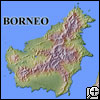Borneo
— Entry 1
Today was a very long but extraordinary day. It began after leaving our
adventure in the Sepilok Wildlife Sanctuary, where we had had some amazing
encounters with orangutans and other creatures.
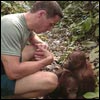
You could say the day kind of started off on the wrong foot ....
We made our way to the coast, planning to board a boat so we could go
diving. We had all these grandiose plans of swimming with an adult green
sea turtle as she was about to haul herself up to lay eggs. We hoped to
film the whole thing — only the camera was broken. So my outlook for the
day at that point was grim, and I was thinking, well, maybe we'll be lucky
and it will get better.
It didn't. The seas were a little choppy when it was time for me to step
into the little vessel, which was really funky, looked like one of those
very expensive high-powered cigarette boats. Where I live on the ocean
they just rip up and down and make all this horrible noise, and I thought,
well, you know, this is cool, we'll get out there lickety-split. But it
turns out that it was all a facade, that this thing was being powered by a
90-horsepower engine, and it was totally fake — even the windshield was
fake.
So it was actually pretty funky and fun as we made our way out to the
islands to find some sea turtles, and of course I then stepped off on the
wrong foot — literally — falling off the boat and going into the drink
with wardrobe and microphone and all. But you know, I got out and shook it
off and prayed that the day would get better. And it did. It ended up
being an amazing day, especially when we came out to the sea turtle
sanctuary.
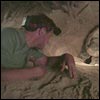 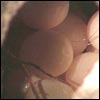 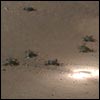
We were there to learn about this sea turtle conservation program the
sanctuary has. I think for me the best experience was to see all those
baby green turtles pour out of the hole after being hatched and be able to
participate in that experience. It was so great to be able to actually
pick up those hatchlings, and then help take down data about them before
releasing them. And the other amazing aspect was getting to see the life
process begin with the eggs being laid, and then seeing it go to the next
level as the sea turtles were released — personally, my experience today
also reminded me of how important this sea turtle program is with regard
to continuing the species. So it was a good day overall, and hopefully
tomorrow will be equally as good.
Borneo — Entry 2
We went to Bakunang
island, and a neighboring island where they had this absolutely fantastic
nursery. It was extraordinarily exciting for me to be there when three
events happened that surround the life of a green sea turtle. Number one,
when those eggs hatched, that was very exciting for me. We had literally
been watching this nest for hours and then all of a sudden a hole appeared
and a crevice was formed. That crevice created like a little crust, which
collapsed in on itself, revealing, oh, 30-plus squirming 3-inch-long green
sea turtles.
And then we had a chance to watch a large female — actually she wasn't
so large, about 150 pounds — haul herself out onto the beach. We
followed her through the whole process, keeping in mind we couldn't
disturb her, as she used her back flippers to excavate a nest and then
deposit her eggs. And just watching those eggs plop out like pingpong
balls coming in on a stream of mucus — it really was just amazing to see
that. We had to be very quiet and stealth-like because if you disturb a
female sea turtle, especially before she lays the eggs, there's a chance
she's going to head right back to the ocean.
The people who worked at this Bakunang hatchery were really hospitable and
made the experience very special for us. We spent the day yesterday
observing the whole life cycle of the green sea turtle: egg deposition and
the nest, hatching and even death (occasionally we'd find hatchlings that
had died).
I actually got to participate in releasing hatchlings into the ocean. We
had gone through all this work to set up equipment and shined this light
to follow the little turtles as they went to sea, but they turned right
around and came back at the camera. Sea turtles train themselves
celestially, and I guess they rely on the moon to take them out to deeper
water so that bright sun-gun was like a moon to them. We had to send
someone out into the water with a battery pack and shine it to draw the
turtles out. That whole experience was really special.
We woke up the next day to find a hatchling sea turtle we'd missed. What
probably happened, I guess, is that all its brothers and sisters had
hatched before it, so we hadn't seen the little straggler. It had spent
the whole morning out in the bright sun in this little protective basket,
which was like a death cage.
When we found the hatchling, it was on its back and suffering, so I picked
it up, walked to the edge of the shore, and opened my hand and just let it
go into the water. One of its flippers was damaged, but when it saw that
water it started swimming as fast as it could. Its fins were going, but
the injured one just wasn't working well and the little guy was gulping
for air. As I sat there on the beach and watched this tiny turtle swimming
against this great horizon, seeing it so hungry for life and knowing it
probably didn't have a chance in the world to survive, that its future was
probably going to end up in the belly of some fish, it just made me think
how alone that little hatching was. And it made me feel lonely just
watching this process. Again, it really crystallized for me how important
this sea turtle-conservation program is.
Now it's the next day and I want to say it's — let me see my watch —
the 15th of July. I'm four days into being 33 years of age, and we've
returned to the Sepilok sanctuary, back to do some more orang stuff. We
were here the day before we went to the islands for the turtles, filming
some orangutans. There were two individuals that were orphaned, both about
1 to 2 years in age, and the younger one was clinging to the other one
like Velcro. Working with those orphans was very powerful for me, and I
think for the whole crew. Your heart just went out for these animals.
First of all, it's uncanny to look at these creatures and see how much we
humans share in common with them. Everything from physiological stuff,
like how our hands and eyes look similar, to their behavior, to their fear
— you could sense their fear, and even the guide said the orphans were
using what is called the buddy technique. To spend time with these
orangutans and be able, even for a short time, to be a part of this
complicated process of taking an animal like this for six or eight years
of its life and trying to give it a chance to survive out in the wild was
an amazing experience. So we're back to that, we're back here in Sepilok
and we've got a lot of work to do tomorrow.
Today was a long day. We had that boat ride all the way out — I got
fried out in the sun — and then we drove all the way back. After taking
a nap, I felt like I had some energy so I decided to go look for some
animals. I was feeling like the show was a little weak in that I hadn't
found any interesting snakes yet. Those are the animals that I love to
discover, that I like to share with the folks who watch our show. So I
spent the night foraging through the forest, trying to find some
interesting things. I found a ton of frogs — I found oh, six, actually
about eight frogs. There are tons of frogs here to be discovered.
And I saw a moon rat (an insectivore sort of like a shrew) about the size
of an opossum, and a palm civet, but no snakes. I trekked through three
miles of jungle, got stung by numerous ants, was the buffet for many a
leech, and yet did not discover a single snake.
As for how things are going production-wise, well you know, it's all new.
We have a new crew, and we're going through a real experimental process of
trial and error, trying to get ourselves up to the point where we want to
be, and that may be two or three episodes from now. But overall the crew's
doing really good.
I'm going to do a little night-spotting in the road to see if I can find
any cobras — oh, that's another thing. I didn't find a snake but someone
found a cobra, a Sumatran black cobra that had been run over. I'm bumming
because I would have liked to have discovered that creature to show our
viewers. So even though I'm exhausted, I'm going to head out there and
just spend some time seeing what I can find. Good night!
Borneo — Entry 3
Urrghh. I am very tired. Phew! Today was a long day. It's one of those
days when you're making a natural history film that's rewarding but
exhausting. And every time you go out on a shoot you have four or five
days like this, and you can't handle six or seven of them. Basically
you're up at 6 a.m. and you finish work at 11 p.m., midnight. The night
before that I was up 'till 2.30 a.m. working, doing some nocturnal stuff.
So I'm starting to feel very fried, but I'm really enjoying Borneo.
Highlights today: First of all, being in that cave was amazing. To
actually get to participate with those men who harvest the swiftlet nests
was exciting. Climbing up that scaffolding, being face to face with those
nests hundreds of feet above the forest floor and realizing that you're
just walking across a — I don't want to say rinky-dink, but you know —
a bamboo frame that's leaning against a limestone face and being strung up
on stalagmites ... well, it was a totally organic experience. And I mean
organic because copious amount of bat feces and swiftlets' feces were
raining down on us. We also had gone in the day before to get some footage
of the bats coming out, which was great.
I actually caught a wrinkle-faced bat and never planned on that — I knew
I was going to try it but didn't think I was going to pull it off. But you
know, two days of the stuff and I woke up that morning before we went to
the cave and my chest was tight and I was nervous. I was thinking that I
was exposing myself to toxins floating in the air, and who knows what
these animals have been eating ... and now I was inhaling whatever it was
and my lungs were probably acting like a petri dish, festering some
bacterial disease. Flashbacks of the movie Outbreak were in the
back of my mind, especially when I looked up and a piece of bat dropping
fell right in my eye and stuck to my cornea. I couldn't get it out and
Piers, the cameraman, had to actually pick it off my eye because it was
fused to the eyeball. And then I got some in my mouth and in my nose, so
that when I blew my nose I literally had a booger that was like a
stalagmite of cave dust — like a total cast of my nasal passage came out
made of bat crap and bird crap and cave minerals.
And then climbing up that scaffold was thrilling. It was scary, it was
exciting, it was great. To see that face to face and to know that I am
probably one of only a few Westerners ever to experience that was really
humbling. It was just an awesome experience.
Of course, the next time I climb a scaffold I'll wear underwear. We're in
a culture that is a bit reserved, and here I am climbing up this thing
without any underwear on, giving a free show. You could hear these guys
laughing and I'm thinking, what am I doing? After we're all done, I'm
looking through the footage to make sure I'm not surprising anybody. I
don't want that to haunt me in the Christmas reel, you know what I'm
saying?
Then at night we searched for crocodiles, which took a long time. We
started at 7:30 a.m. and didn't wrap until nearly midnight. And we had a
full moon, which literally made us visible to the crocodiles. I'd come
within a foot of a crocodile and he'd just disappear when he saw me. So
finally, the crew and I had things set up so that I move in, and they're
right behind me ready to shoot, yada yada, and after 40 attempts, and
hours of doing this, I finally catch a crocodile and I turn around and the
crew isn't there. They're filming an owl, half a mile away. Didn't even
tell me. I had a walkie-talkie, and they never said anything. I was so
pissed. So we tried it again, and luckily I did manage to catch another
crocodile on film. Then we went to bed and crashed. All in all it was a
very good day
Borneo — Entry 4
Today was a great day. I think it was one of the best days
I've had so far in Borneo. It began with a search for elephants
— we found them. We hiked deep into the interior through the
most impenetrable brush jungle — a wall of snarly, thorny
vegetation — and suddenly the air exploded with the trumpets
and rumbles of 40 elephants. Now I've seen lots of elephants in
Africa and I've seen elephants in Thailand, but I'd never
encountered an elephant deep in the jungle. It's a very, very
eerie, hair-on-your back-raising sort of experience, because you
hear a deafening roar and you look and you see a wall of
vegetation and behind that wall is a leathery wall with an
eyelid and an eye looking right at you. It's like being in a
horror movie, and there were times that we were really scared.
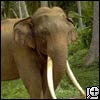
The biologist I was with, Burt, told me you just have to hold
your ground and I did. I held my ground and it didn't work; the
elephant tried to trample me, but I jumped out of the way,
hitting Piers the cameraman ... man, what a thrilling day.
And then I finally found a snake. Borneo has been tough. I mean,
it's wonderful. The wildlife is great. But the last time I was
in Borneo I caught a lot of snakes (11, I think), and this time
I'd been here for over a week and had yet to catch one. On this
trip, I've caught bats and scorpions; I've been fed on by a
tiger leech in my groin area; I've caught a slender-toed gecko,
a crocodile, but I still hadn't caught a snake. Until today.
Thank gosh, on our way back today there was a beautiful
6-foot-long (2 meters), mildly venomous, spectacular mangrove
snake hanging in a tree. So I feel like now we're all set.
|
